A Comparative Study of the Properties of Recycled Concrete Prepared with Nano-SiO2 and CO2 Cured Recycled Coarse Aggregates Subjected to Aggressive Ions Environment
Abstract
:1. Introduction
2. Materials and Experimental Details
2.1. Raw Materials and Mixture Ratio
2.2. Nano-SiO2 and CO2 Curing of Recycled Coarse Aggregates (RCA)
2.3. Recycled Concrete (RC) Preparation and Aggressive Ions Attack Experiment
2.4. Macro and Micro Characterization of Recycled Concrete (RC)
2.4.1. Ions Permeability Test
2.4.2. Surface Products Analysis of the Modified Recycled Coarse Aggregates (RCA)
2.4.3. Micro-Mechanical Properties and Micro-Morphology Analysis of Recycled Concrete (RC)
3. Results and Discussion
3.1. Basic Performance Indexes of Recycled Coarse Aggregates (RCA)
3.2. Macro Performance of Recycled Concrete (RC) after Ion Erosion
3.3. Micro-Performance Analysis of Recycled Concrete (RC) after Ion Erosion
3.3.1. Micromechanical Properties of ITZs in Modified Recycled Concrete (RC) under Different Erosion Environments
3.3.2. Micromorphology of Modified Recycled Concrete (RC)
3.3.3. Elements Distribution of ITZs in Modified Recycled Concrete (RC) under Different Erosion Environments
3.4. Mechanism Analysis
4. Conclusions
Author Contributions
Funding
Institutional Review Board Statement
Informed Consent Statement
Data Availability Statement
Conflicts of Interest
References
- Wang, Q.B.; Zhang, J.; Liu, K.; Xu, A.D.; Xu, H.L.; Yang, M.C.; Wang, C.; Yang, R.S.; Bao, G.T.; Liu, Y.F.; et al. Study on performance tests and the application of construction waste as subgrade backfill. Materials 2021, 14, 2381. [Google Scholar] [CrossRef] [PubMed]
- Li, Q.Y.; Quan, H.Z.; Jiang, Y. Recycled Aggregate of Concrete, 1st ed.; China Building Industry Press: Beijing, China, 2020; pp. 7–11. [Google Scholar]
- Plaza, P.; del Bosque, I.S.; Frías, M.; de Rojas, M.S.; Medina, C. Use of recycled coarse and fine aggregates in structural eco-concretes. Physical and mechanical properties and CO2 emissions. Constr. Build. Mater. 2021, 285, 122926. [Google Scholar] [CrossRef]
- Li, H.; Guo, Q.J.; Wang, J.B.; Zhang, K.F. Interface Transition Zone Structure and Durability of Recycled Aggregate Concrete: A review. Mater. Rep. 2020, 34, 13050–13057. [Google Scholar]
- Xu, F.W.; Tian, B.; Xu, G. Influence of the ITZ thickness on the damage performance of recycled concrete. Adv. Mater. Sci. Eng. 2021, 202, 6643956. [Google Scholar]
- Sivamani, J.; Renganathan, N.T. Effect of fine recycled aggregate on the strength and durability properties of concrete modified through two-stage mixing approach. Environ. Sci. Pollut. Res. 2021. [Google Scholar] [CrossRef]
- Zhang, Y.C.; Chen, X.Y.; Zhou, J.H.; Huang, J. Interfacial transition zone characteristics of recycled concrete: A review. IOP Con. Ser. Earth Environ. Sci. 2021, 692, 042051. [Google Scholar] [CrossRef]
- Wang, Z.X.; Li, Q.Y.; Xie, R.P.; Li, Q.Q. Quantitative analysis of multi interface of carbonated recycled concrete. Concrete 2017, 7, 15–17. [Google Scholar]
- Zhan, B.J.; Xuan, D.X.; Poon, C.S.; Scrivener, K.L. Characterization of interfacial transition zone in concrete prepared with carbonated modeled recycled concrete aggregate. Cem. Concr. Res. 2020, 136, 106175. [Google Scholar] [CrossRef]
- Yan, H.S. Experimental Study on Mechanical Properties of Recycled Coarse Aggregate Concrete Strengthened with Nano SiO2. Master’s Thesis, Qingdao University of Technology, Qingdao, China, 2017. [Google Scholar]
- Yang, Z.Y. Influence of Nano-Silica Soaked Recycled Aggregates on Properties of Concrete. Master’s Thesis, Shenzhen University, Shenzhen, China, 2018. [Google Scholar]
- Zeng, W.L.; Zhao, Y.X.; Zheng, H.B.; Poon, C.S. Improvement in corrosion resistance of recycled aggregate concrete by nano silica suspension modification on recycled aggregates. Cem. Concr. Compos. 2019, 106, 103476. [Google Scholar] [CrossRef]
- Xiao, J.Z.; Li, B.; Zhang, K.J.; Su, Y.W.; Pan, Y.B. Dynamic mechanical properties of nano-silica modified recycled aggregate concrete under uniaxial compression. J. Tongji Univ. Nat. Sci. 2021, 49, 30–39. [Google Scholar]
- Qiu, J.S.; Tng, D.Q.S.; Yang, E.H. Surface treatment of recycled concrete aggregate through microbial carbonate precipitation. Constr. Build. Mater. 2014, 57, 144–150. [Google Scholar] [CrossRef]
- Guo, Y.X.; Li, Q.Y.; Li, Q.Q.; Yue, G.B. Prediction Formula for Absolute Water Consumption of Recycled Coarse Aggregate Concrete. DEStech Trans. Mater. Sci. Eng. 2017. [Google Scholar] [CrossRef] [Green Version]
- Li, Y.; Fu, T.H.; Wang, R.J.; Li, Y. An assessment of microcracks in the interfacial transition zone of recycled concrete aggregates cured by CO2. Constr. Build. Mater. 2020, 236, 117543. [Google Scholar] [CrossRef]
- Younis, K.; Mustafa, S. Feasibility of using nanoparticles of SiO2 to Improve the Performance of recycled aggregate concrete. Adv. Mater. Sci. Eng. 2018, 2018, 1512830. [Google Scholar] [CrossRef] [PubMed] [Green Version]
- Min, H.G.; Sui, L.S.; Xing, F.; Tian, H.; Zhou, Y.G. An effective transport model of sulfate attack in concrete. Constr. Build. Mater. 2019, 216, 365–378. [Google Scholar] [CrossRef]
- Gao, S.; Gong, Y.Y.; Ban, S.L.; Hou, S.M. The effect of ion erosion on the microstructure of multiple interface zone of recycled concrete. Bull. Chin. Ceram. Soc. 2020, 39, 2567–2573. [Google Scholar]
- Ministry of Transport of the People’s Republic of China. Testing Code of Concrete for Port and Water Engineering: JTJ 270-1998; China Communication Press: Beijing, China, 1998; pp. 57–59.
- Cao, J.R.; Jin, Z.Q.; Wang, P.G. Sulfate corrosion of concrete exposed to marine environment. J. Civ. Environ. Eng. 2019, 41, 104–109. [Google Scholar]
- Cao, Y.B.; Li, Q.Y.; Wang, Z.X.; Xie, R.P. Reconstruction technique and application of multi interface ucture model of recycled concrete. Bull. Chin. Ceram. Soc. 2017, 36, 2678–2682. [Google Scholar]
- Li, Q.Y.; Li, Q.Q.; Yue, G.B.; Guo, Y.X. Effect of carbonation on the interfacial microstructure of recycled concrete. J. Shenyang Jianzhu Univ. Nat. Sci. 2017, 33, 629–636. [Google Scholar]
- Ying, J.W.; Han, Z.W.; Shen, L.M.; Li, W.G. Influence of parent concrete properties on compressive strength and chloride diffusion coefficient of concrete with strengthened recycled aggregates. Materials 2020, 13, 4631. [Google Scholar] [CrossRef]
- Singh, L.P.; Bisht, V.; Aswathy, M.S.; Chaurasia, L.; Gupta, S. Studies on performance enhancement of recycled aggregate by incorporating bio and nano materials. Constr. Build. Mater. 2018, 181, 217–226. [Google Scholar] [CrossRef]
- Yue, G.B.; Ma, Z.M.; Liu, M.; Liang, C.F.; Ba, G.Z. Damage behavior of the multiple ITZs in recycled aggregate concrete subjected to aggressive ion environmen. Constr. Build. Mater. 2020, 245, 118419. [Google Scholar] [CrossRef]
- Yue, G.B. Study on the Recycled Concrete Multi-Interface Structure and the Damage Mechanism of Performance. Ph.D. Thesis, Qingdao University of Technology, Qingdao, China, 2018. [Google Scholar]
- Mukharjee, B.B.; Barai, S.V. Influence of Nano-Silica on the properties of recycled aggregate concrete. Constr. Build. Mater. 2014, 55, 29–37. [Google Scholar] [CrossRef]
- Geng, J.; Sun, J.Y.; Mo, L.W.; Zhang, G.L. Microstructure characteristics of recycled fine aggregate and concrete. J. Civ. Environ. Eng. 2013, 35, 135–140. [Google Scholar]
- Liang, C.F.; Pan, B.H.; Ma, Z.M.; He, Z.H.; Duan, Z.H. Utilization of CO2 curing to enhance the properties of recycled aggregate and prepared concrete: A review. Cem. Concr. Compos. 2019, 105, 103446. [Google Scholar] [CrossRef]
- Wang, R.J.; Yu, N.N.; Li, Y. Methods for improving the microstructure of recycled concrete aggregate: A review. Constr. Build. Mater. 2020, 242, 118164. [Google Scholar] [CrossRef]
- Mehta, P.K.; Montillo, B.J.M. Concrete: Microstructure, Properties, and Materials, 4th ed.; China Building Industry Press: Beijing, China, 2016; pp. 115–116. [Google Scholar]
- Qin, S.S.; Zou, D.J.; Liu, T.J.; Jivkov, A. A chemo-transport-damage model for concrete under external sulfate attack. Cem. Concr. Res. 2020, 132, 106048. [Google Scholar] [CrossRef]
- Vishwakarma, V.; Uthaman, S.; Dasnamoorthy, R.; Kanagasabai, V. Investigation on surface sulfate attack of nanoparticle-modified fly ash concrete. Environ. Sci. Pollut. Res. 2020, 27, 41372–41380. [Google Scholar] [CrossRef]
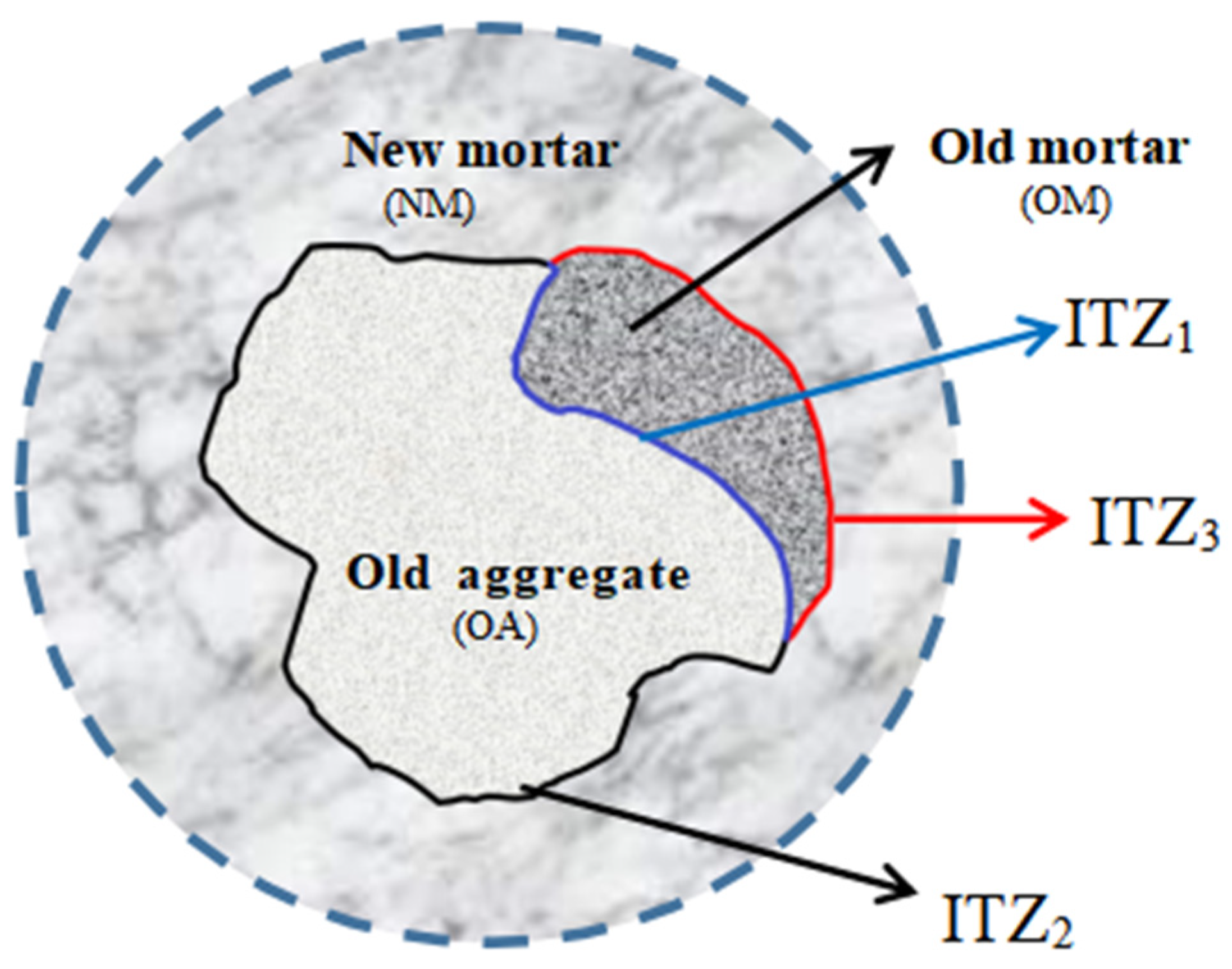
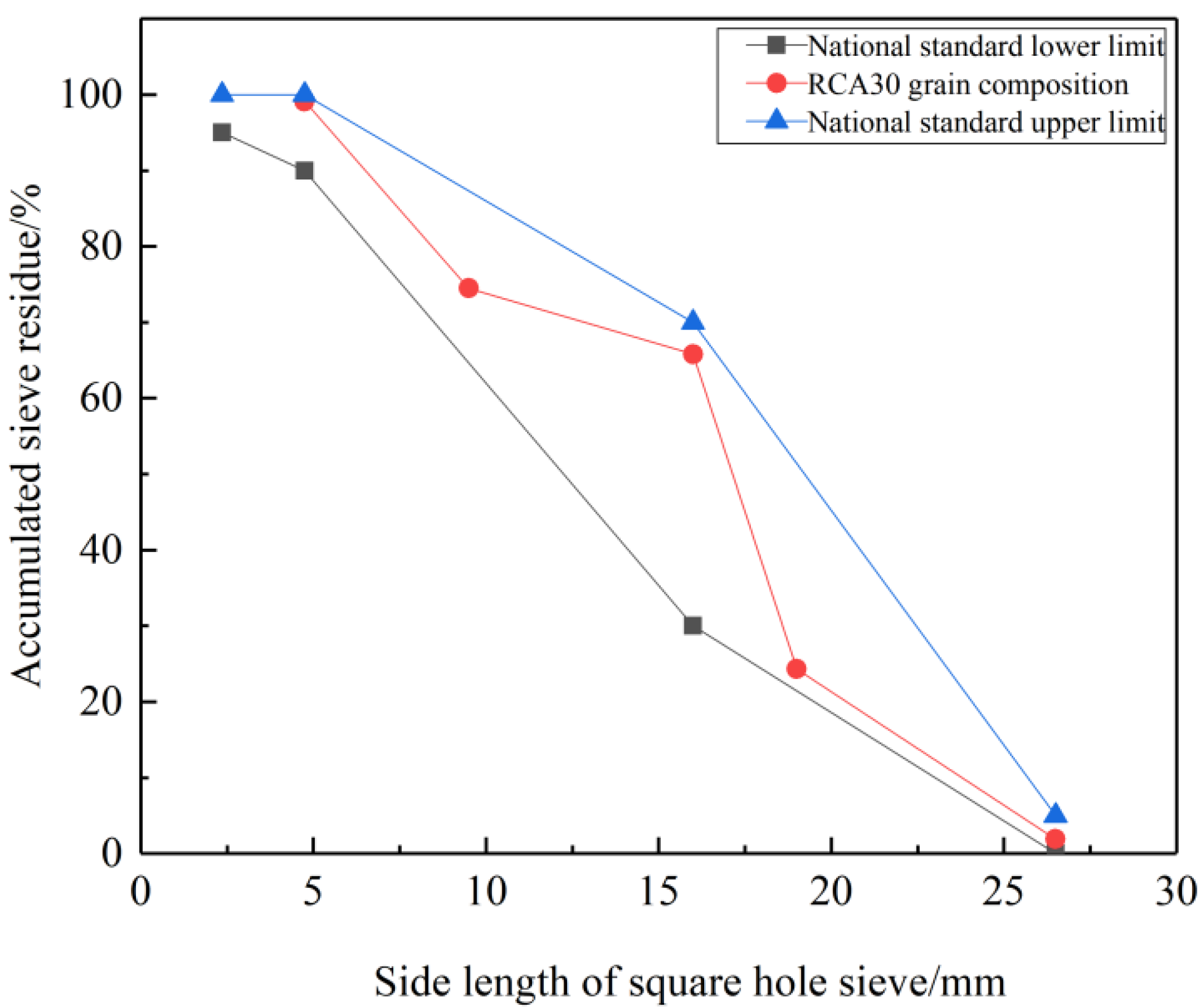
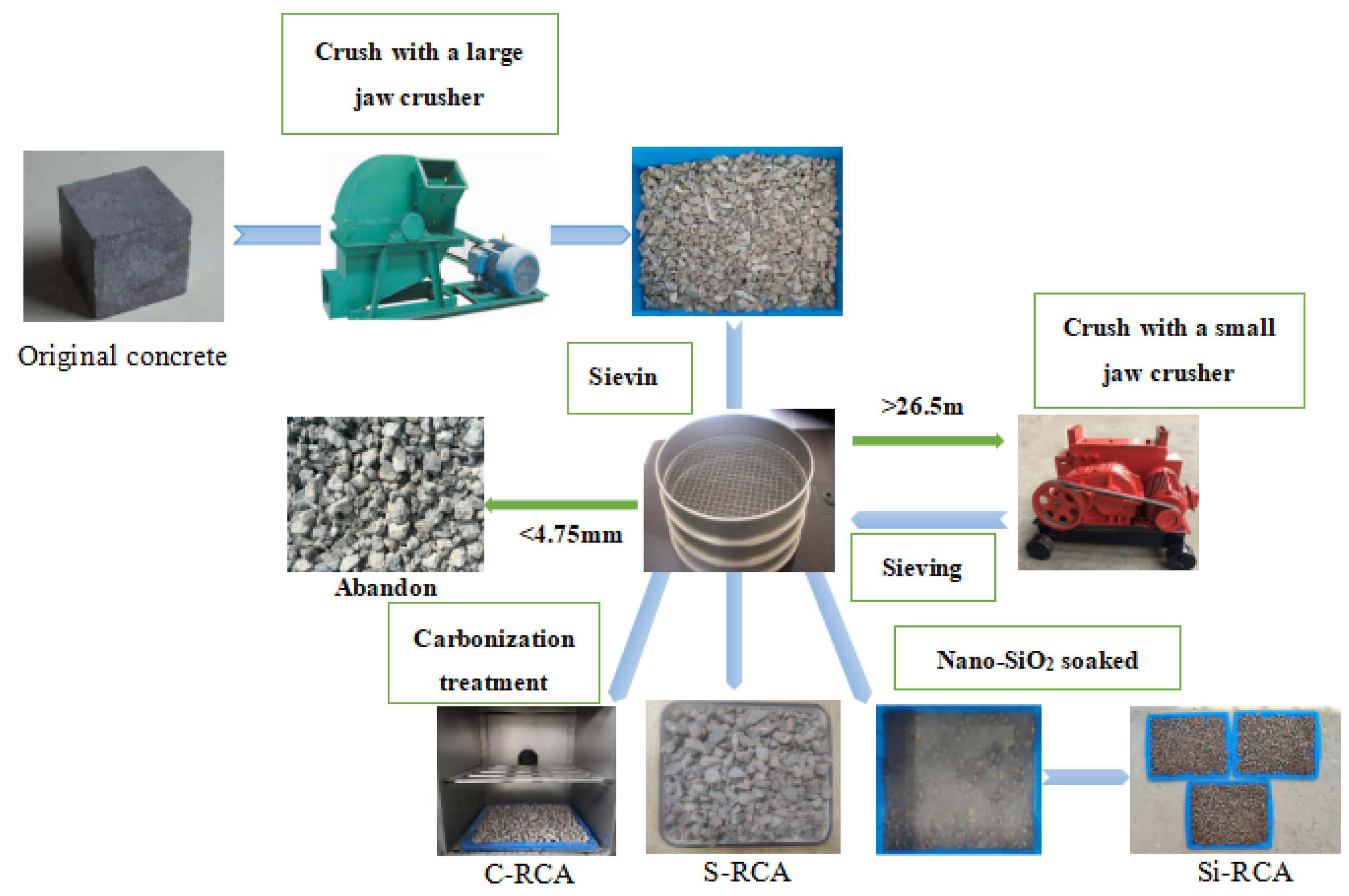
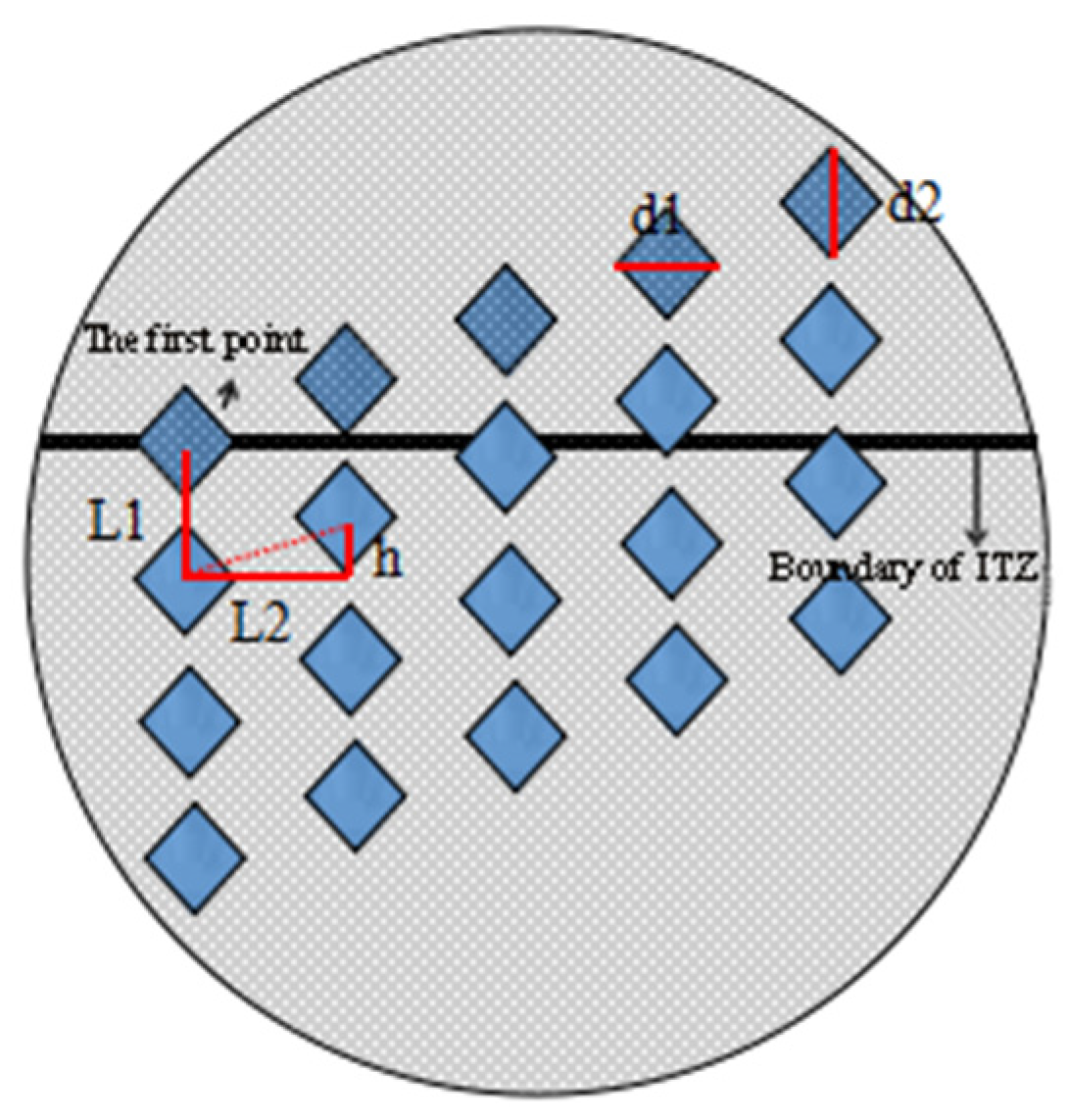

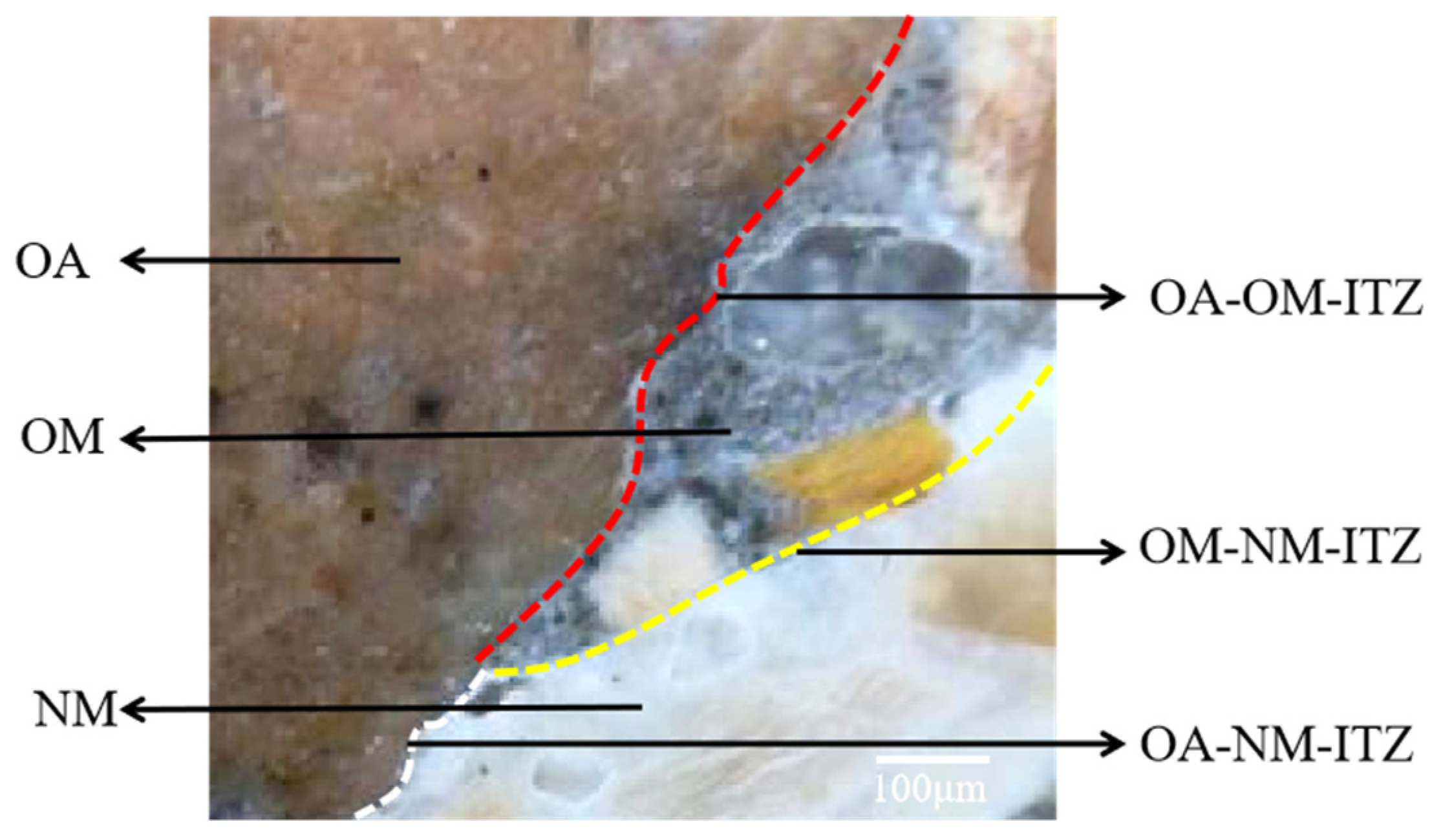
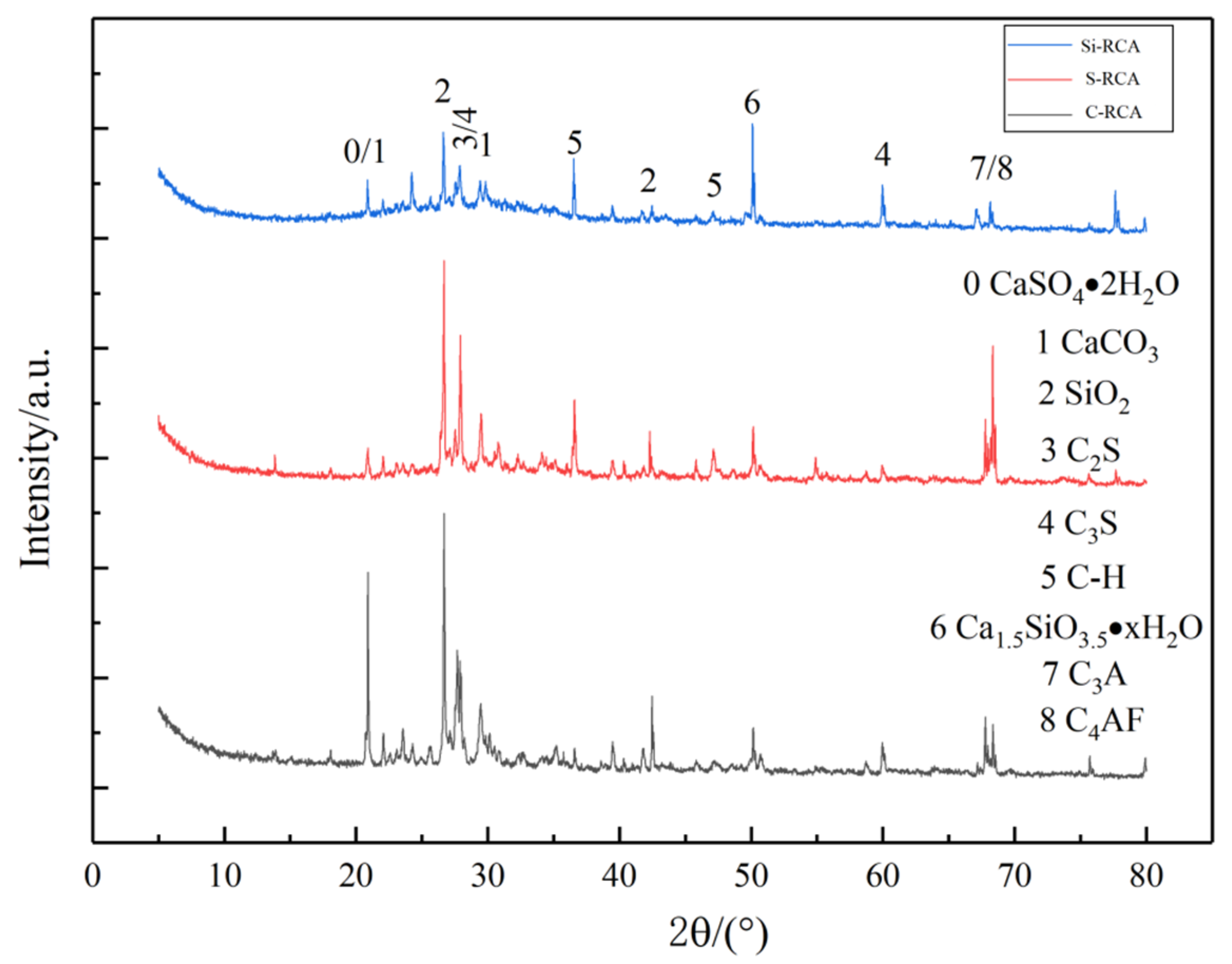

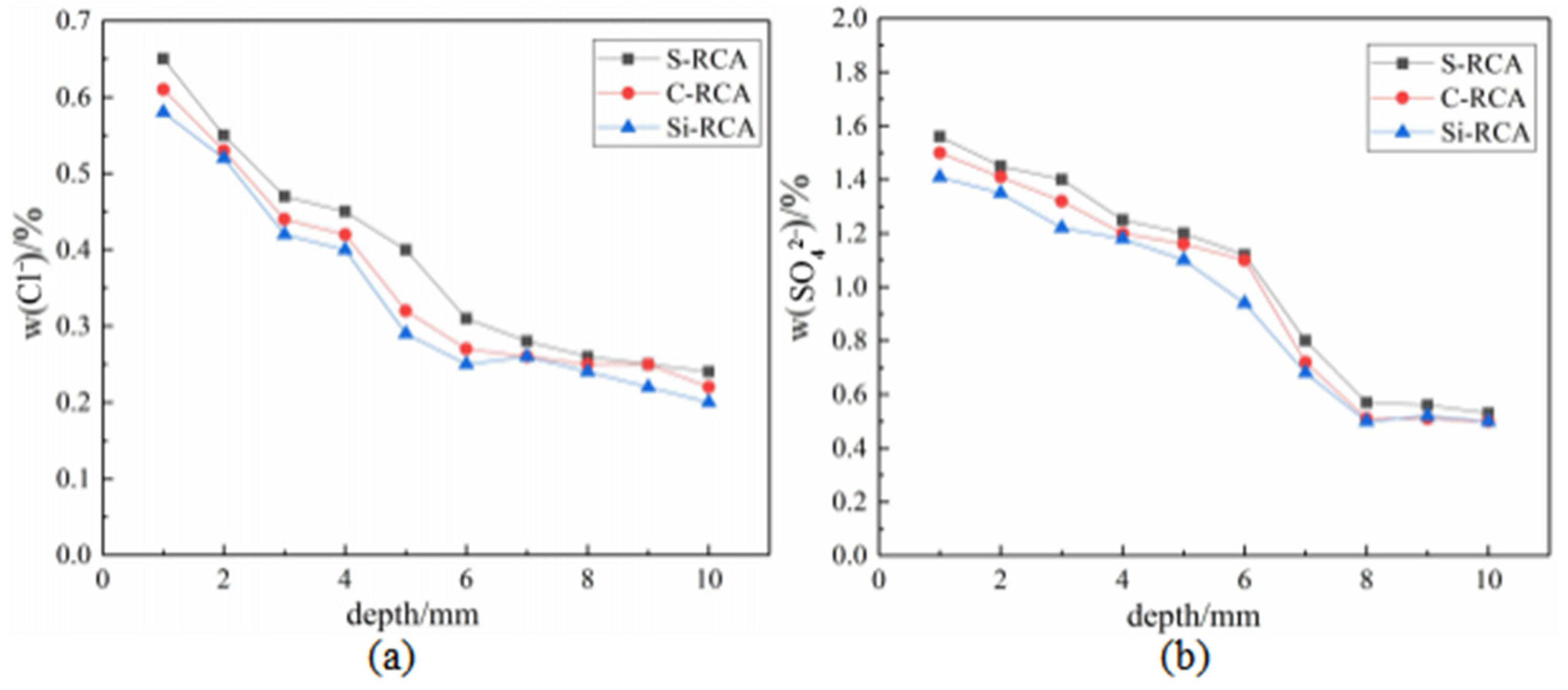
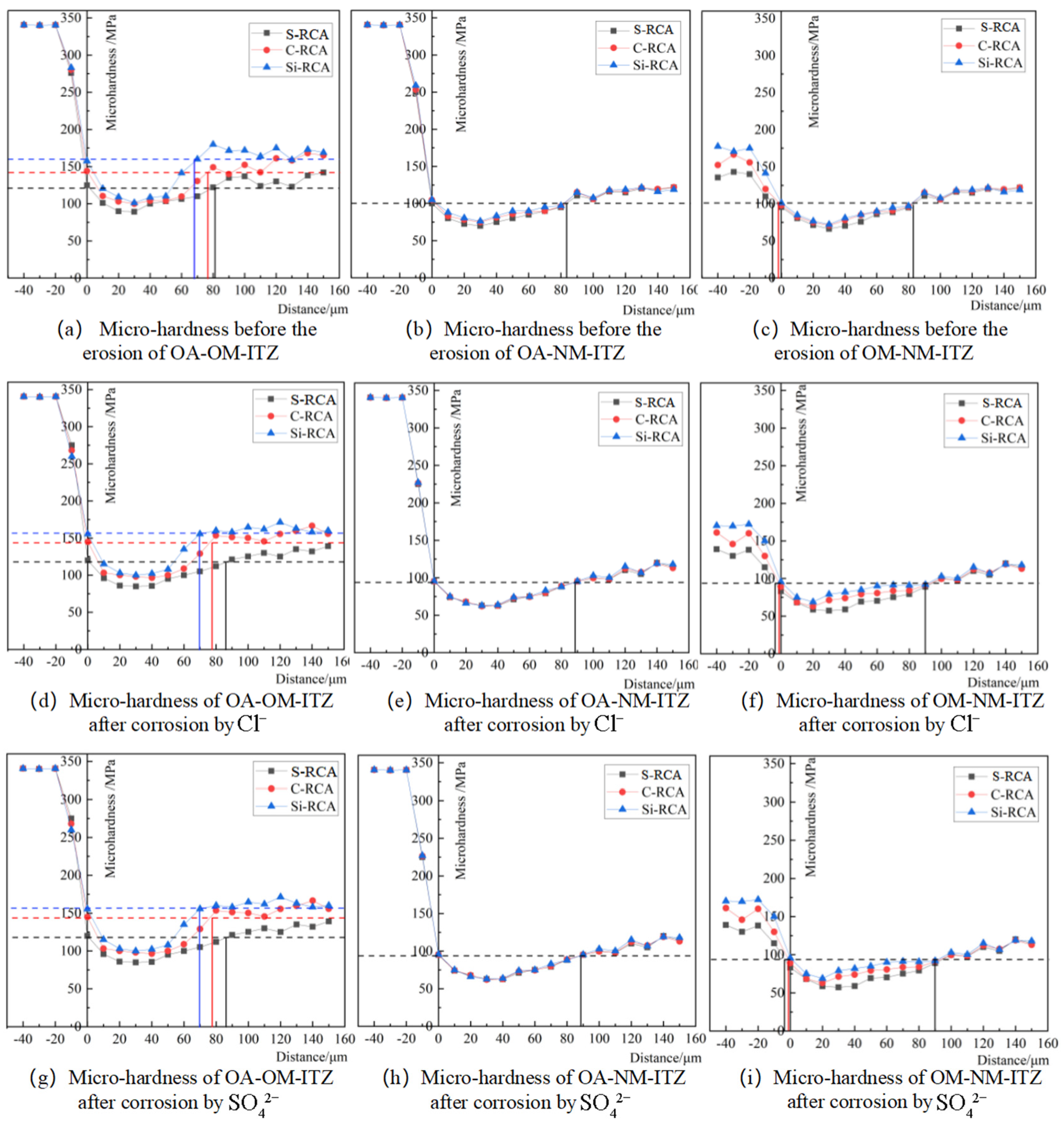
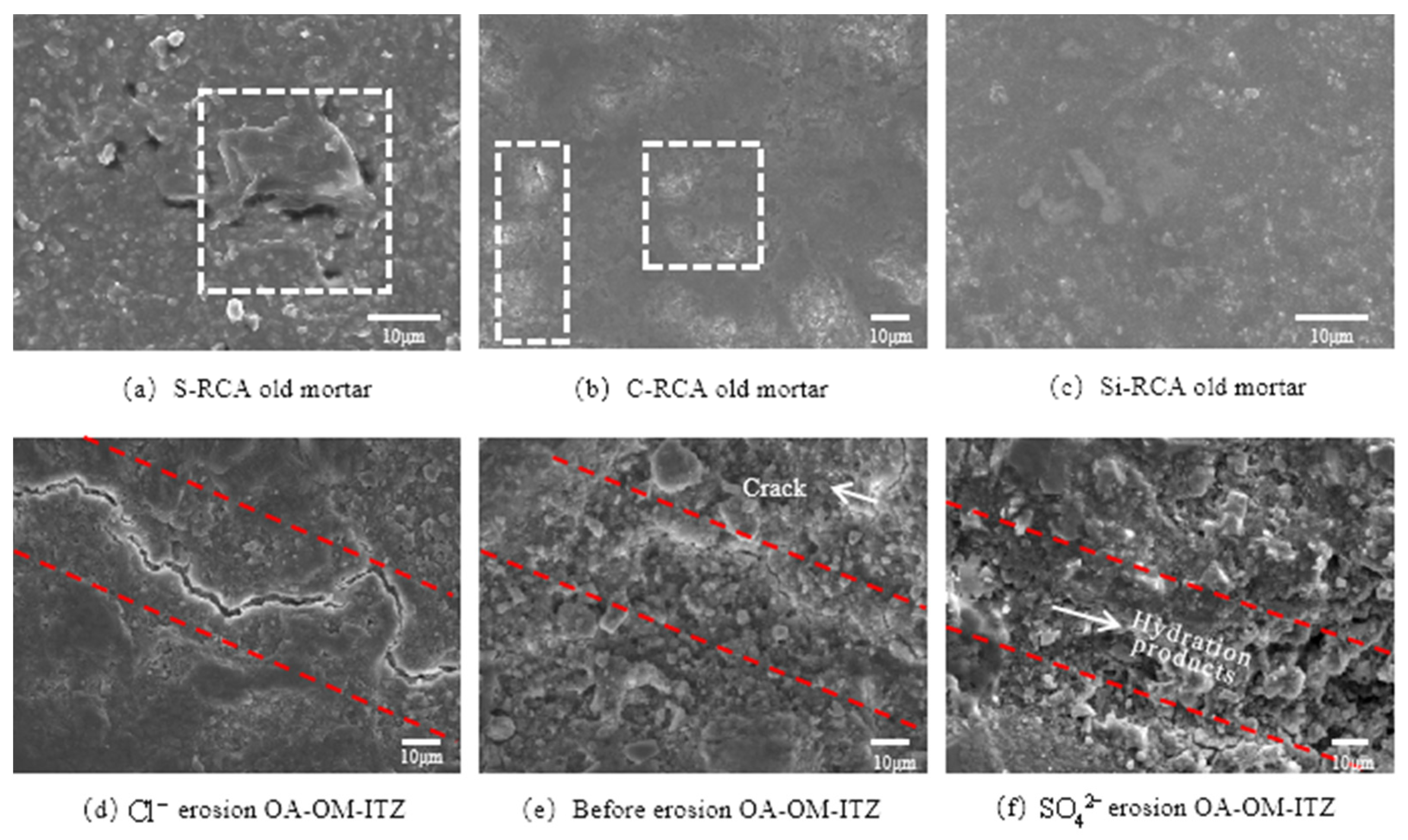

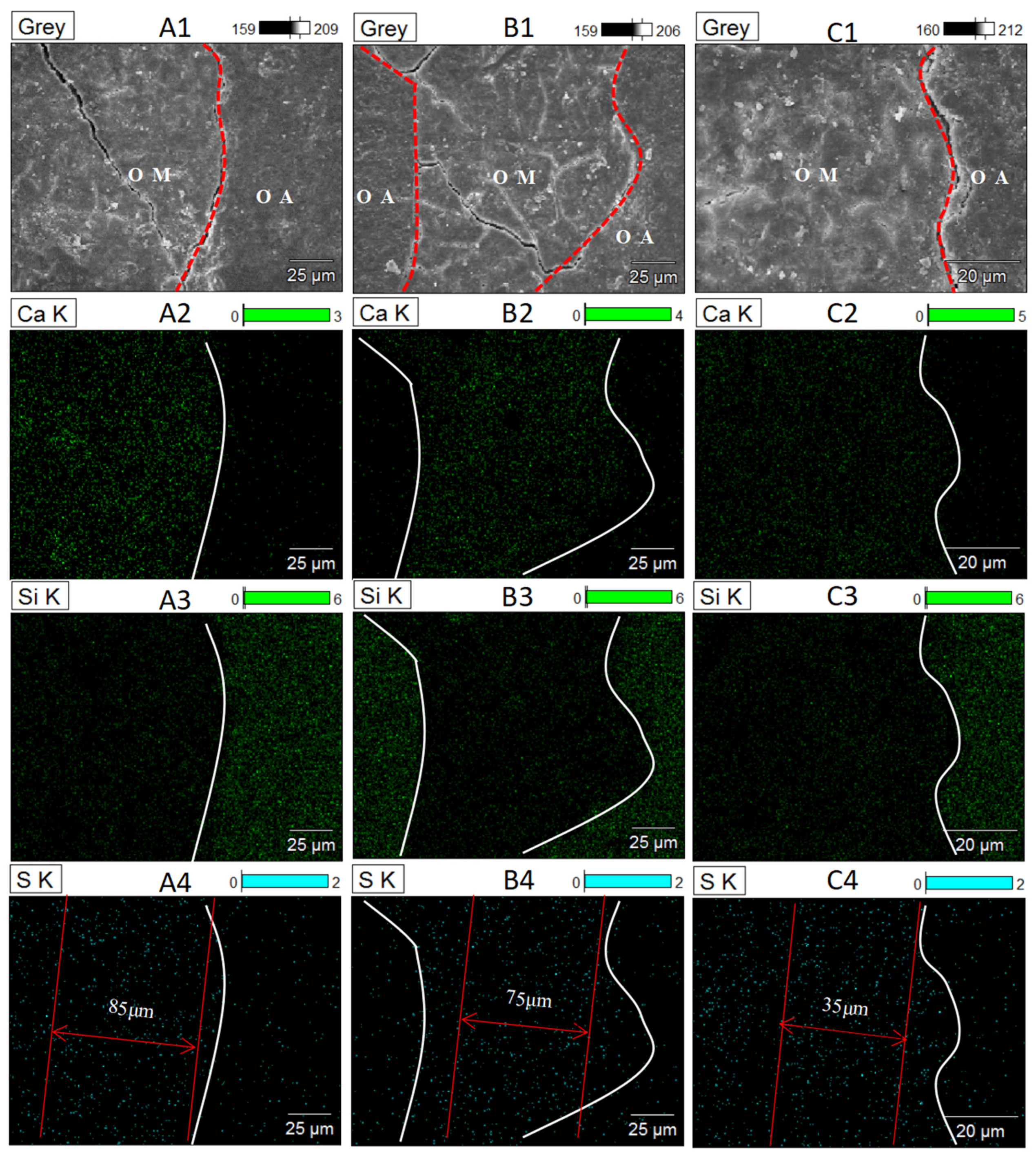
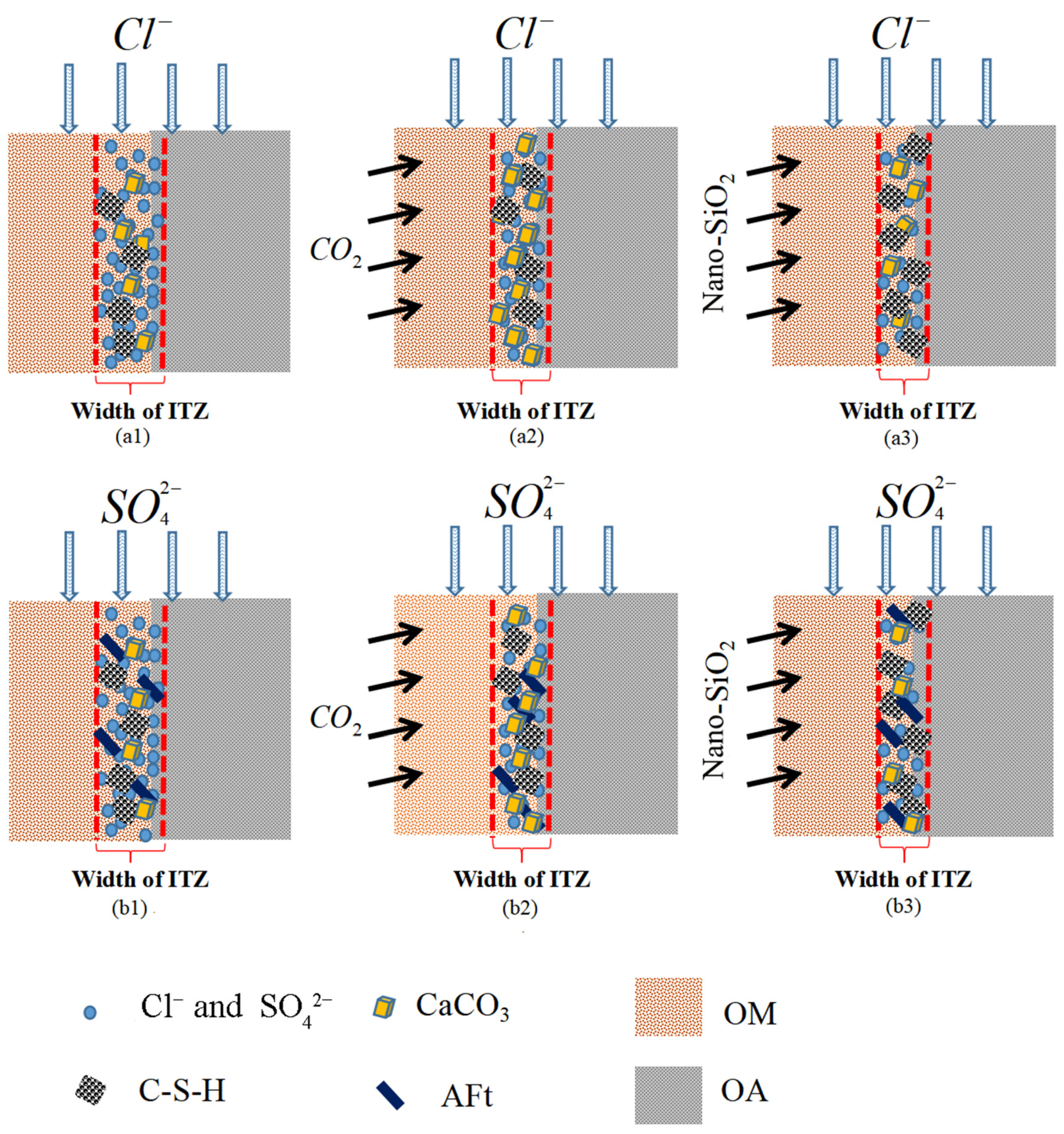
| Strength Grade | Cement kg/m3 | Fine Aggregate kg/m3 | Coarse Aggregate kg/m3 | W/B | W (Water Reducing Agent)% | 28 d Compressive Strength MPa |
|---|---|---|---|---|---|---|
| C30 | 300 | 780 | 1170 | 0.39 | 1 | 45.1 |
| Strength Grade | White Cement kg/m3 | Fine Aggregate kg/m3 | Coarse Aggregate kg/m3 | W/B | W (Water Reducing Agent)% |
|---|---|---|---|---|---|
| C45 | 350 | 750 | 980 | 0.46 | 1 |
| Types of RCA | Crush Indicators % | Water Absorption % | The Apparent Density kg/m3 | Void Fraction % |
|---|---|---|---|---|
| S-RCA | 13.27 | 5.82 | 2477.17 | 50.61 |
| C-RCA | 11.21 | 5.76 | 2523.81 | 48.28 |
| Si-RCA | 9.91 | 5.27 | 2519.57 | 49.08 |
Publisher’s Note: MDPI stays neutral with regard to jurisdictional claims in published maps and institutional affiliations. |
© 2021 by the authors. Licensee MDPI, Basel, Switzerland. This article is an open access article distributed under the terms and conditions of the Creative Commons Attribution (CC BY) license (https://creativecommons.org/licenses/by/4.0/).
Share and Cite
Gao, S.; Gong, Y.; Li, N.; Ban, S.; Liu, A. A Comparative Study of the Properties of Recycled Concrete Prepared with Nano-SiO2 and CO2 Cured Recycled Coarse Aggregates Subjected to Aggressive Ions Environment. Materials 2021, 14, 4960. https://doi.org/10.3390/ma14174960
Gao S, Gong Y, Li N, Ban S, Liu A. A Comparative Study of the Properties of Recycled Concrete Prepared with Nano-SiO2 and CO2 Cured Recycled Coarse Aggregates Subjected to Aggressive Ions Environment. Materials. 2021; 14(17):4960. https://doi.org/10.3390/ma14174960
Chicago/Turabian StyleGao, Song, Yaoyao Gong, Nan Li, Shunli Ban, and Ang Liu. 2021. "A Comparative Study of the Properties of Recycled Concrete Prepared with Nano-SiO2 and CO2 Cured Recycled Coarse Aggregates Subjected to Aggressive Ions Environment" Materials 14, no. 17: 4960. https://doi.org/10.3390/ma14174960
APA StyleGao, S., Gong, Y., Li, N., Ban, S., & Liu, A. (2021). A Comparative Study of the Properties of Recycled Concrete Prepared with Nano-SiO2 and CO2 Cured Recycled Coarse Aggregates Subjected to Aggressive Ions Environment. Materials, 14(17), 4960. https://doi.org/10.3390/ma14174960






